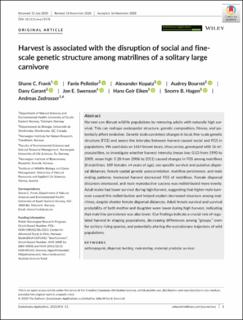| dc.description.abstract | Harvest can disrupt wildlife populations by removing adults with naturally high survival. This can reshape sociospatial structure, genetic composition, fitness, and potentially affect evolution. Genetic tools can detect changes in local, fine-scale genetic structure (FGS) and assess the interplay between harvest-caused social and FGS in populations. We used data on 1614 brown bears, Ursus arctos, genotyped with 16 microsatellites, to investigate whether harvest intensity (mean low: 0.13 from 1990 to 2005, mean high: 0.28 from 2006 to 2011) caused changes in FGS among matrilines (8 matrilines; 109 females ≥4 years of age), sex-specific survival and putative dispersal distances, female spatial genetic autocorrelation, matriline persistence, and male mating patterns. Increased harvest decreased FGS of matrilines. Female dispersal distances decreased, and male reproductive success was redistributed more evenly. Adult males had lower survival during high harvest, suggesting that higher male turnover caused this redistribution and helped explain decreased structure among matrilines, despite shorter female dispersal distances. Adult female survival and survival probability of both mother and daughter were lower during high harvest, indicating that matriline persistence was also lower. Our findings indicate a crucial role of regulated harvest in shaping populations, decreasing differences among “groups,” even for solitary-living species, and potentially altering the evolutionary trajectory of wild populations. anthropogenic, dispersal, hunting, male mating, maternal, predator, survival | |
